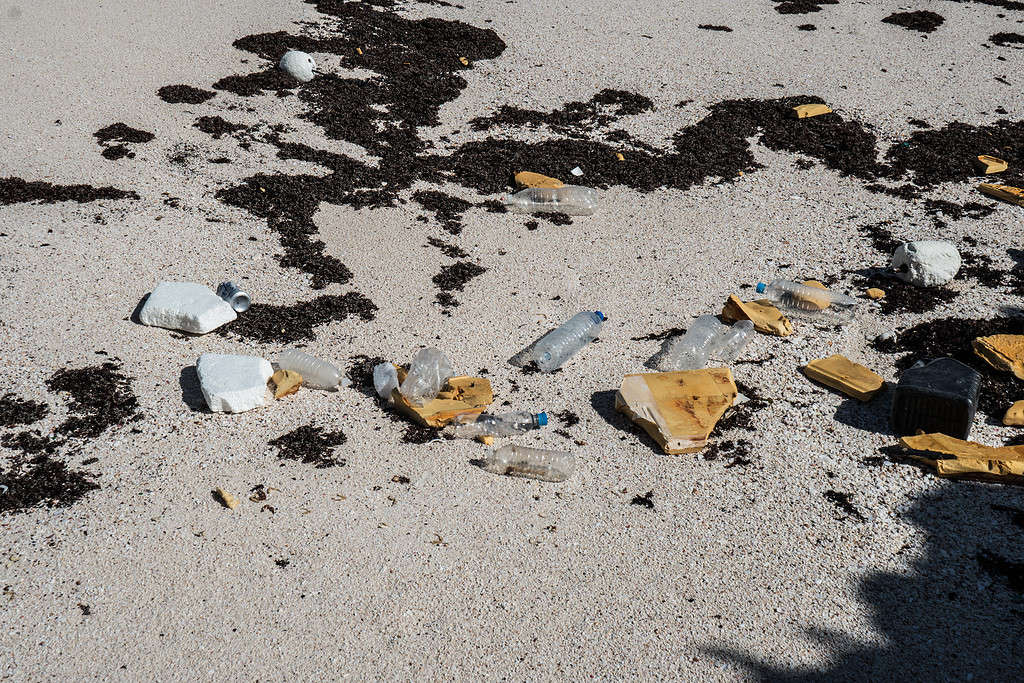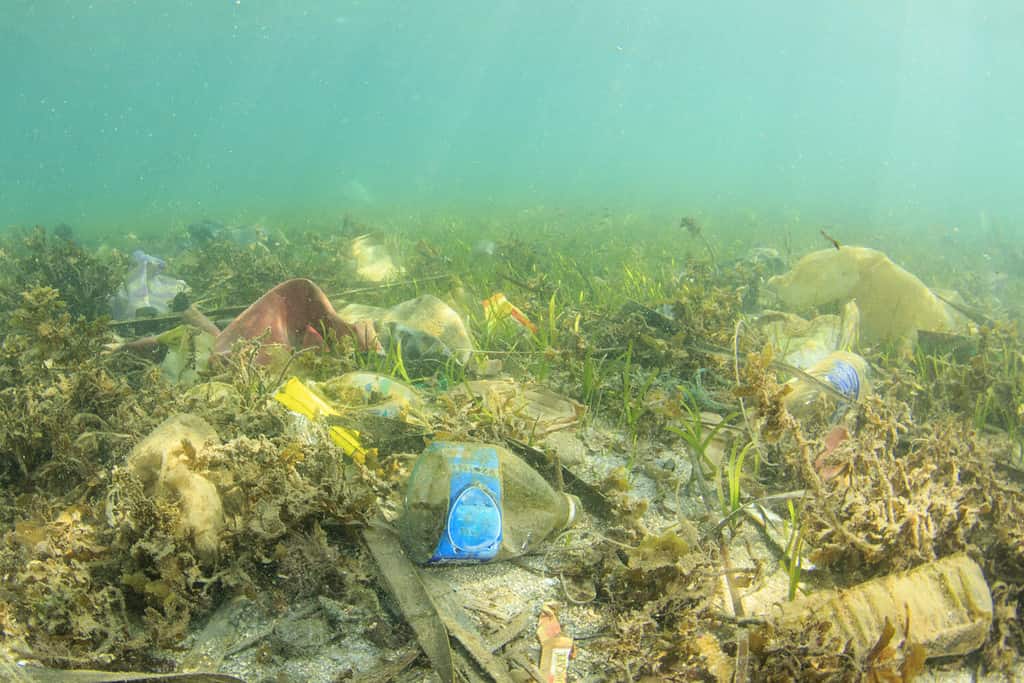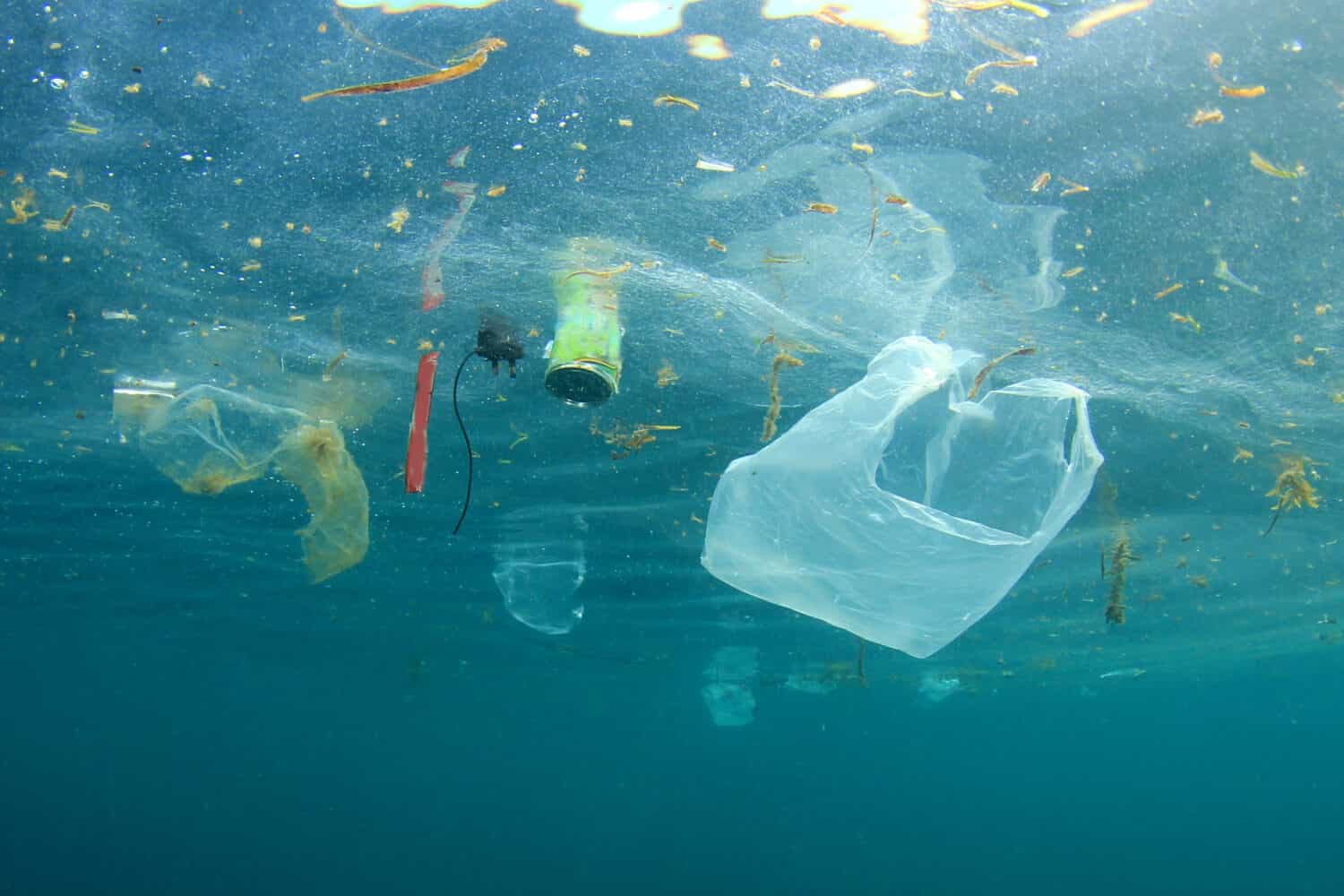If you’ve been present at all on social media over the past couple of decades, chances are you’ve at least heard of the Great Pacific garbage patch. You might have a basic understanding of what it is, and probably where it is. But if you’ve ever wondered exactly what formed it, where it came from, and what you can do about it, this is the piece for you. This is your primer on the Great Pacific garbage patch.
What is The Great Pacific Garbage Patch?

©PLASTIKATLAS | Appenzeller/Hecher/Sack, CC BY 4.0 – Original / License
The Great Pacific garbage patch is an enormous collection of garbage, largely plastics, that has accumulated within the North Pacific Gyre. A gyre is a cyclical current of ocean water. The North Pacific Gyre is the largest ocean gyre. It includes the currents that flow near North America, Asia, and Australia.
The garbage patch itself covers around 620,000 square miles of the Pacific Ocean. It includes between 45,000 and 129,000 metric tons of plastic. This was back in 2018, so the numbers have almost definitely increased since then. Most of the plastic within the garbage patch is the size of your fingernail or smaller. A majority of it being microplastics. In fact, 90% of the plastic within the garbage patch has not yet broken down into microplastics. It includes lighters, pens, baby bottles, cell phones, plastic bags, plastic wrappers, water bottles, lighters, and more.
Even though there is so much garbage, and it covers such a large area, the Great Pacific garbage patch is hard to find. Some online videos and pictures show giant islands of garbage or floating piles of plastic. These do not exist in the Great Pacific garbage patch. The area the garbage patch occupies is so vast that the large amounts of plastic are spread out and do not accumulate in large floating islands. The average density of the patch is about four particles per three cubic yards.
That doesn’t mean it isn’t a problem. Even though it is hard for our minds to comprehend the size of the patch, and of the ocean in general, this is still a vast amount of garbage that is harming the environment. It is growing rapidly. The garbage patch is expanding about 10-fold every decade. It now holds six pounds of plastic for every pound of plankton. The accumulation of garbage affects ecosystems and environments outside its immediate area. These effects will continue to increase over time.
Where is The Great Pacific Garbage Patch?

A picture of some of the most common items found in the ocean. It will eventually break down into more harmful particulates.
©Rich Carey/Shutterstock.com
If you’re looking for a map to find a giant island of garbage, I have bad news for you. Most of the plastic is too small to notice. Even if you were sailing right through the center of the garbage patch, you wouldn’t know it was there.
The North Pacific Gyre, which is what creates the Great Pacific garbage patch, is a circular current that flows in and between the Pacific Rim. The exact area of the garbage patch is indefinite. The garbage within it is always moving and flowing with the waves and ocean currents. The greatest accumulation of garbage within the patch, however, is located in a portion known as the Eastern Garbage Patch. This area lies between California and Hawaii. Other large patches are found off the coast of Japan, and in the North Pacific.
What Causes The Great Pacific Garbage Patch?

Plastic waste on Bang Saen Beach, Chonburi, Thailand. These will inevitably break down into microplastics, or be ingested by wildlife.
©bombermoon/iStock via Getty Images
Normally, a majority of the garbage found in the ocean comes from land-based sources. However, a 2018 study discovered that between 75% and 86% of the plastic found in the Great Pacific garbage patch comes from fishing and agriculture activities. Around half of the garbage in total comes from synthetic fishing nets alone.
Another study in 2015 sought to determine the sources of the plastic and garbage in the Great Pacific Garbage Patch. It found that the top six contributors to the pollution were, in order, China, Indonesia, The Philippines, Vietnam, Sri Lanka, and Thailand. In fact, China, Indonesia, the Philippines, Thailand, and Vietnam contribute more plastic to ocean pollution than the rest of the world combined. China by itself accounts for over 30% of all ocean pollution.
The most commonly identifiable objects found in the Great Pacific garbage patch include fish boxes, oyster equipment, fishing nets, farming equipment, eel and fish traps, food packaging, drink containers, and household plastics.
If any of this plastic is discarded, thrown into the ocean, or flows downriver into the Pacific Ocean, it will inevitably flow toward the Northern Pacific Gyer. The combination of strong ocean currents, waves, and surface winds will drive this garbage into the Great Pacific garbage patch. There, it will be trapped until it breaks down.
The Future of The Great Pacific Garbage Patch

Ocean trash washes up on the beach in the Bahamas. As Human’s dependency on plastic increases, the world’s oceans are becoming more and more polluted. Scientists say there will be more plastic in the ocean than fish by 2030.
©TraceRouda/iStock via Getty Images
The effects of the Great Pacific garbage patch are no different than typical ocean pollution. The breakdown of plastic garbage into microplastics will continue to adversely affect the wildlife. The effects in the area around the Great Pacific garbage patch will be worse because of the higher concentration of plastic that is trapped there.
When ocean wildlife consumes these microplastics, they will eventually find their way into our diet. Consuming plastic is generally not a healthy part of the human diet. If too much plastic is in the water, the plants and animals may begin to die. Food shortages may then ensue. Coral reefs may die. Beaches may become unsuitable for recreation. Also, some microorganisms thrive on plastic. The accumulation of microplastics may encourage these microorganisms to grow beyond their usual levels, destroying habitats, beaches, and ecosystems.
Numerous cleanups and environmental efforts have been launched to help clean up the Great Pacific garbage patch. Yet, it will continue to grow while pollution outgrows cleanup initiatives.
One of the scariest issues about the Great Pacific garbage patch is that we have never had to deal with something like this before. It only began to grow during the 1900s with the invention of plastic. It has only continued to grow at a rapid pace. We don’t actually know how big it can get, what will happen when (or if) it reaches an environmental tipping point, or if it is even possible to prevent it from growing at all. Researchers and scientists all agree that ocean pollution is bad for the planet, for the ocean, and for continued human existence. But they can’t say how bad, exactly, the impacts of the Great Pacific garbage patch will be.
What Can You Do To Help?

Limiting the single-use plastics we use, and treating our trash properly can help pollution in general.
©Rich Carey/Shutterstock.com
The sad part is, that there isn’t much you can do. While the world’s largest polluters continue to pour garbage into the ocean, it is a losing battle. It is discouraging, especially since so many of us depend on the Pacific Ocean for food and livable weather.
While healthy practices of recycling, using sustainable materials, and generally not throwing your garbage straight into the ocean are good, these efforts are dwarfed by the daily pollution of other countries.
The Great Pacific garbage patch is too big, too far away, and growing too rapidly for any regular citizen to do anything to help. If you have some sway within the modern fishing industry, you can try to make use of more sustainable fishing equipment or try to limit the amount of equipment that gets discarded into the ocean.
The best thing for you to do is support cleanup efforts. Research the companies and organizations that are trying to clean up the garbage that is already present in the garbage patch. Learn about environmental causes you can support. Vote and support legislation that might help the problem from getting worse in the future.
Thank you for reading! Have some feedback for us? Contact the AZ Animals editorial team.








